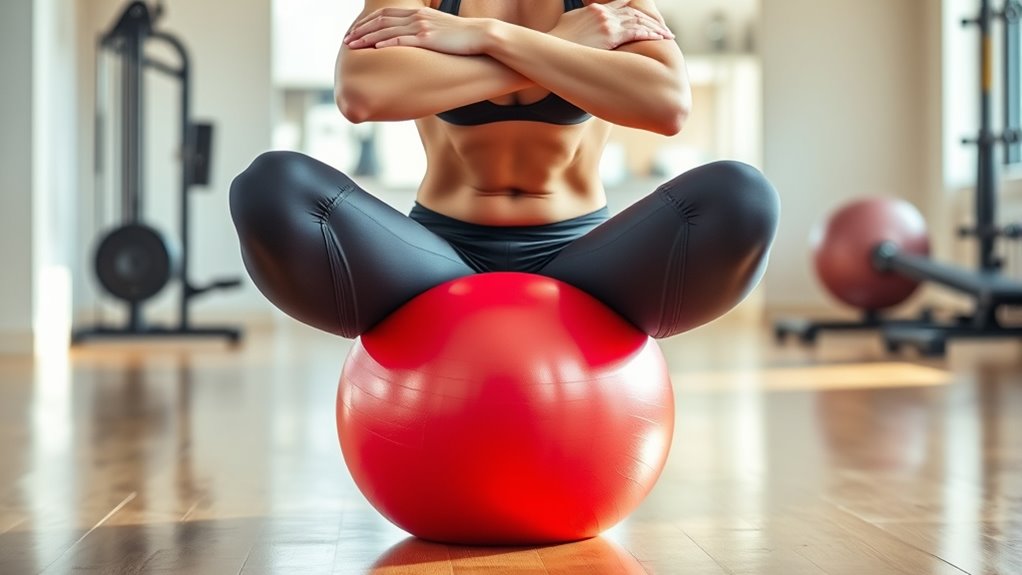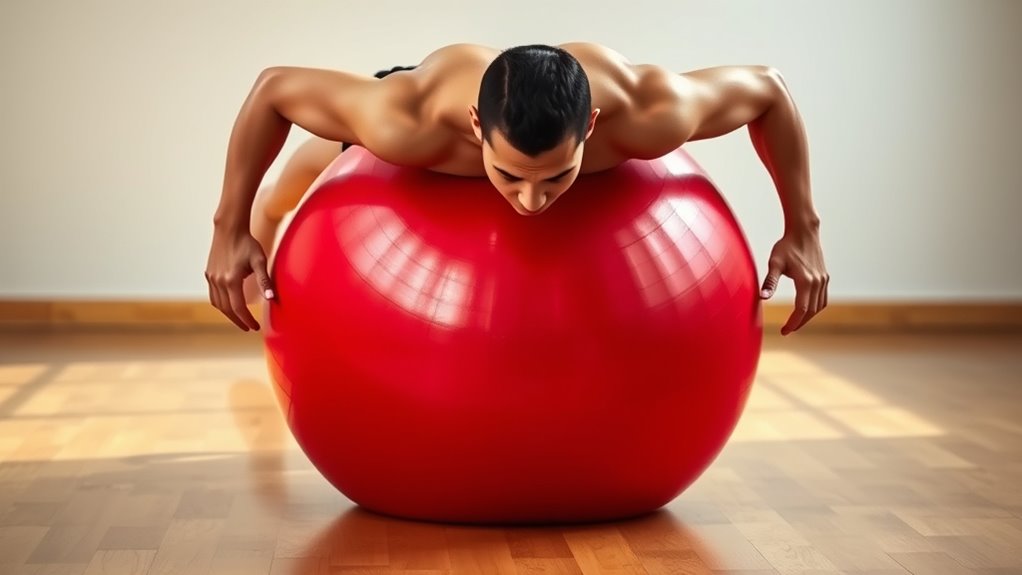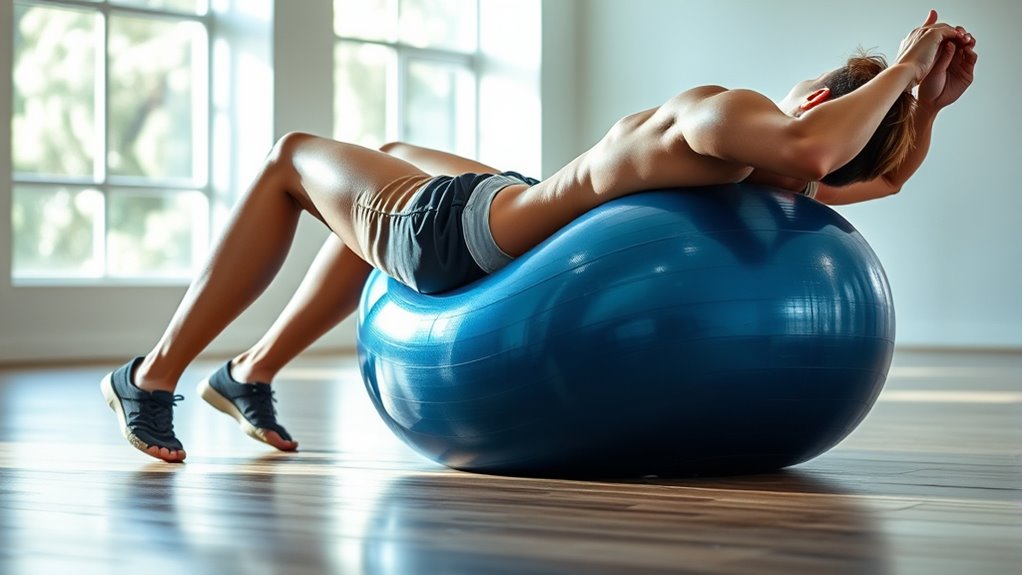To strengthen your core with stability ball exercises, start with basic crunches, focusing on controlled movements and steady breathing. Incorporate planks on the ball to improve balance, then try roll-outs to enhance stability and core activation. Adding bridges on the ball targets your glutes and abs, while seated balance and reach develop coordination. Keep your movements controlled and maintain proper posture; you’ll discover more tips to elevate your routine as you continue exploring.
Key Takeaways
- Engage core muscles during exercises like crunches, planks, and roll-outs to maximize core strength benefits.
- Maintain proper body alignment and neutral spine to prevent injuries and enhance stability during ball exercises.
- Incorporate controlled breathing techniques to improve focus, muscle engagement, and workout effectiveness.
- Use the unstable surface of the ball to activate stabilizer muscles and improve overall balance.
- Combine various exercises such as bridges, seated reaches, and roll-outs for a comprehensive core workout.
Basic Stability Ball Crunches

To effectively target your abdominal muscles, you can incorporate basic stability ball crunches into your workout routine. Focus on core activation by engaging your abs throughout the move. Sit on the ball with your feet flat on the ground, then slowly roll back until your shoulders rest on the ball. Keep your neck relaxed and hands behind your head or crossed over your chest. Use controlled breathing techniques—inhale as you lower, exhale as you crunch up—to maximize effectiveness. Avoid using momentum; instead, concentrate on squeezing your abs during the upward phase. Maintain a neutral spine and steady breathing to improve stability and muscle engagement. Incorporating proper exercise techniques ensures you perform the movements correctly and reduce the risk of injury. Recognizing narcissistic traits in yourself or others can help maintain healthy boundaries during your workouts and daily interactions. Staying consistent with your routine will lead to better core strength and overall stability. With consistent practice, these crunches will help strengthen your core and enhance overall stability.
Plank With Stability Ball

Building on the core engagement from stability ball crunches, incorporating a plank with a stability ball adds an extra challenge to your workout. This move intensifies core activation and enhances balance training. To perform it:
Enhance your core with a stability ball plank for increased balance and strength.
- Place your forearms on the ball, elbows aligned under shoulders.
- Extend your legs behind you, balancing on toes and forearms.
- Keep your body in a straight line, engaging your core throughout.
- Focus on maintaining proper body alignment to maximize effectiveness and reduce injury risk.
- The unstable surface of the ball forces small, continuous adjustments, boosting balance training.
This variation challenges your stability and forces you to maintain proper alignment, improving overall core strength. The unstable surface of the ball forces small, continuous adjustments, boosting balance training. Remember to breathe steadily, avoid sagging hips, and hold the position as long as you can with control. Incorporate this exercise into your routine for a more dynamic core workout.
Stability Ball Roll-Outs

Stability Ball Roll-Outs are an effective way to strengthen your core and enhance stability by engaging multiple muscle groups simultaneously. As you roll the ball forward, your abdominal muscles activate to control the movement, promoting core activation. Keep your back straight and shoulders stable to maximize engagement and prevent injury. This exercise also boosts your balance enhancement, as you rely on your core to maintain control during the roll-out. Moving slowly and deliberately guarantees you target the right muscles and improve overall stability. Incorporating roll-outs into your routine can prevent injury and help develop a stronger, more resilient core. With consistent practice, you’ll notice better posture, improved coordination, and increased functional strength for everyday activities.
Bridge on the Stability Ball

Performing a bridge on the stability ball effectively targets your glutes, hamstrings, and lower back muscles while challenging your balance and coordination. To maximize core activation, focus on proper ball positioning: place your upper back and shoulders on the ball, feet flat and hip-width apart, with knees bent at 90 degrees. Keep your hips lifted, engaging your glutes and core throughout. Remember these key points:
- Maintain a neutral spine to avoid strain.
- Keep your core engaged to stabilize your pelvis.
- Adjust ball positioning as needed for comfort and stability.
- Incorporating core strengthening exercises like this can enhance overall stability and support your fitness goals.
This exercise enhances core strength by forcing your stabilizers to work harder to keep you balanced. Concentrate on controlled movements and steady breathing for ideal results.
Seated Balance and Reach

Seated Balance and Reach on the stability ball enhances your core stability and improves coordination. As you sit on the ball, engage your abdominal muscles to maintain proper posture and prevent slouching. Focus on keeping your spine aligned and shoulders relaxed, which supports posture improvement. Reach one arm forward or to the side, maintaining balance without wobbling. This movement challenges your stabilizer muscles and encourages active engagement of your core. Incorporating controlled breathing techniques—inhale deeply before reaching and exhale slowly as you extend—to maximize stability and focus. Maintaining proper posture during these exercises is essential for preventing strain and maximizing benefits. Understanding the importance of core muscle engagement can further enhance your exercise effectiveness. Additionally, choosing appropriate stability ball size can significantly improve your exercise experience and safety. Regular practice helps develop better posture habits and strengthens your core muscles, making daily activities easier and reducing strain. Using low-carb and keto-friendly alternatives can help support your overall health goals as you incorporate these exercises into your routine. Seated Balance and Reach is an effective, low-impact exercise for enhancing overall stability and coordination.
Frequently Asked Questions
Can Stability Ball Exercises Prevent Lower Back Pain?
You might wonder if stability ball exercises can prevent lower back pain. They promote core activation, which stabilizes your spine and reduces strain. By strengthening your core muscles, you lower the risk of injury and improve posture. Regularly incorporating these exercises helps prevent lower back pain, making your back stronger and more resilient. So, yes, stability ball workouts can be an effective part of injury prevention for your lower back.
How Often Should I Perform Stability Ball Core Workouts?
Think of your workouts like watering a plant—you need just the right amount. For stability ball core exercises, aim for 2-3 sessions weekly, ensuring your exercise frequency supports progress without burnout. Keep workout durations around 20-30 minutes, so you stay engaged and avoid fatigue. Consistency beats intensity, so stick to a manageable schedule, and you’ll build strength while reducing risk of injury.
Are Stability Ball Exercises Safe for Pregnant Women?
You might wonder if stability ball exercises are safe during pregnancy. Generally, with exercise modifications and careful attention to equipment safety, they can be safe, but always consult your healthcare provider first. Avoid exercises that involve lying flat or cause discomfort. Use a stable, properly inflated ball, and listen to your body. Prioritizing safety helps you stay active while protecting your pregnancy.
What Is the Best Size of Stability Ball for Beginners?
When choosing a stability ball size for beginners, your goal is to find one that allows your knees to be at a 90-degree angle when sitting on it. For most adults, a 55-65 cm ball works well. Focus on ball size selection and beginner exercise tips by ensuring comfort and proper posture. This helps you build confidence and prevents injury as you start incorporating stability ball exercises into your routine.
Do Stability Ball Exercises Improve Athletic Performance?
Stability ball exercises can definitely boost your athletic performance by improving balance training and flexibility enhancement. When you use a stability ball, you challenge your stabilizing muscles, leading to better coordination and proprioception. This translates to improved agility and control in sports and daily activities. Incorporating these exercises into your routine helps you develop a stronger, more resilient body, enhancing overall athletic ability and reducing injury risk.
Conclusion
Don’t let doubts hold you back—stability ball exercises are safe and effective when done correctly. Incorporate these moves into your routine to build core strength, improve balance, and boost overall stability. Even if you’re new to fitness or worried about losing balance, start slow and focus on form. With consistency, you’ll notice progress and feel more confident. Give these exercises a try—you’ll be surprised how quickly your core becomes stronger and more stable.









